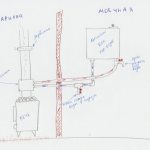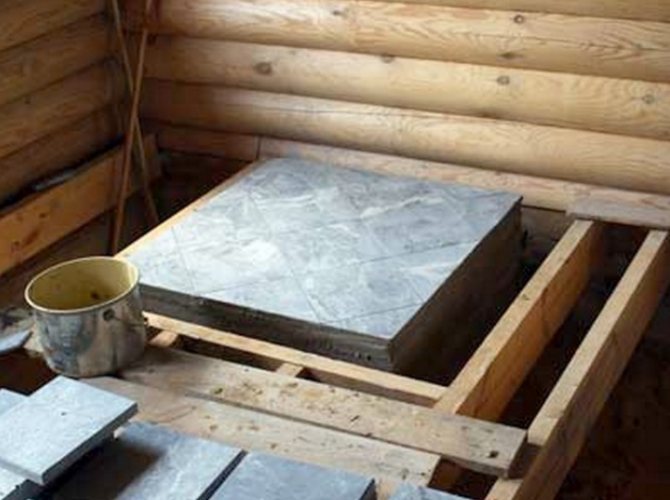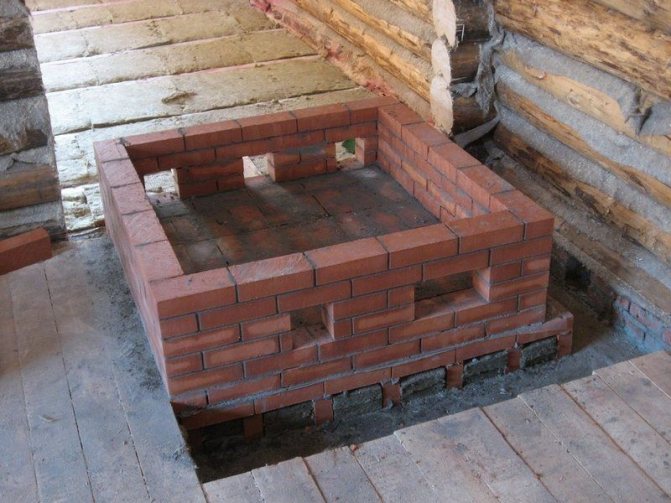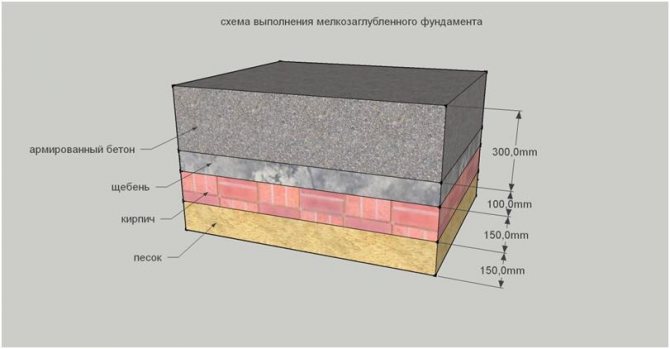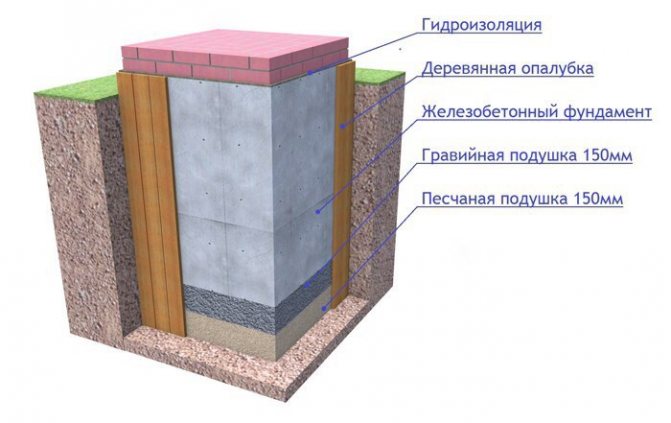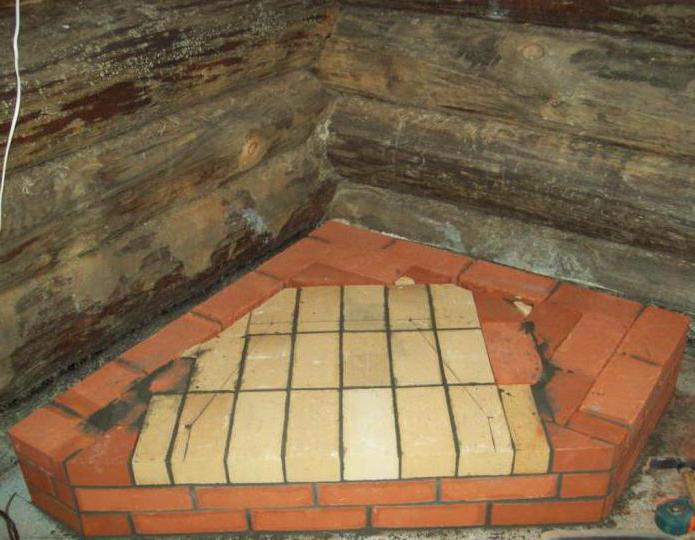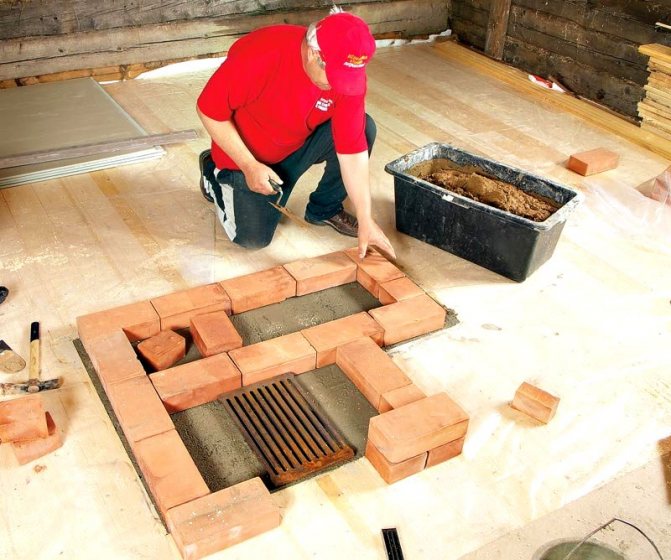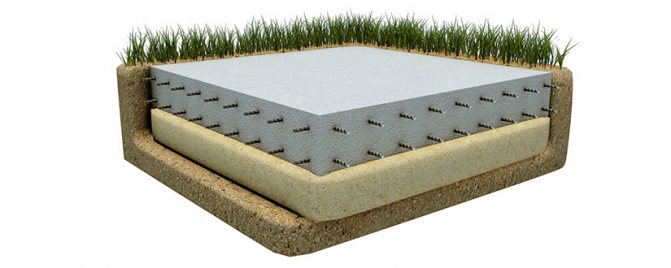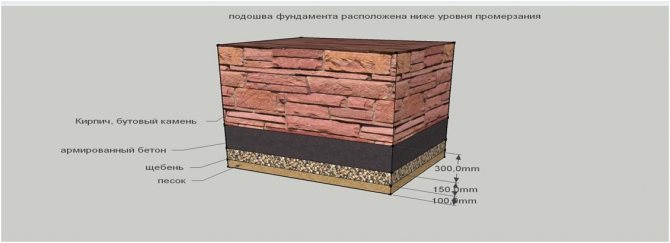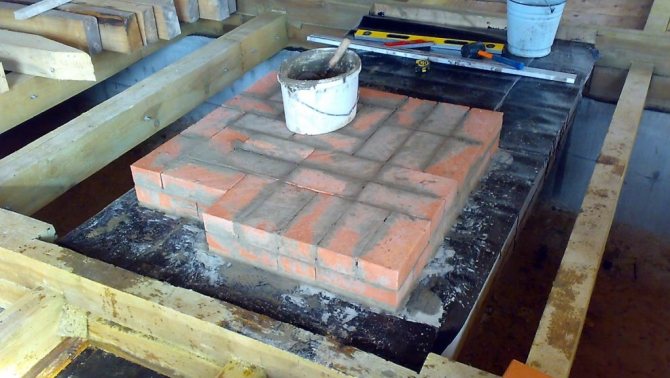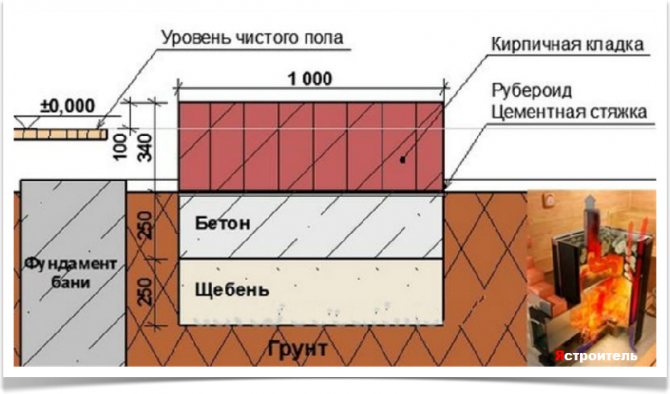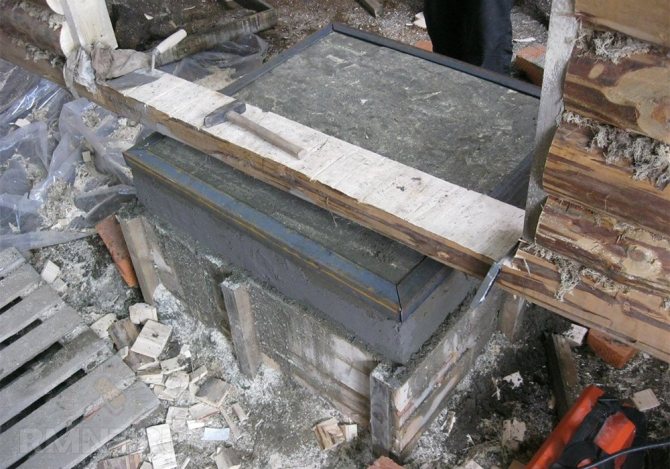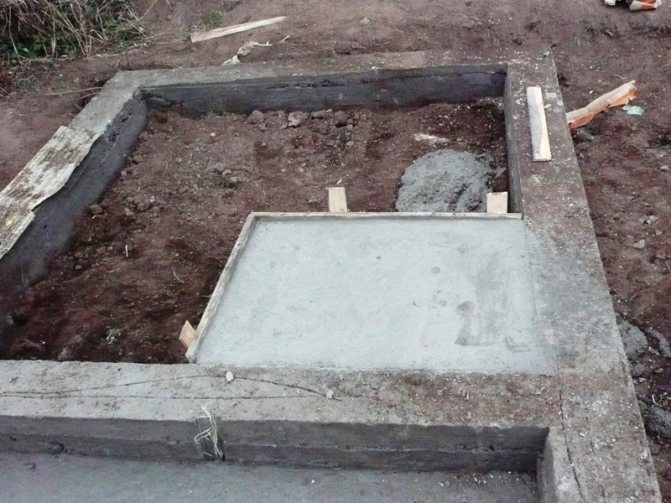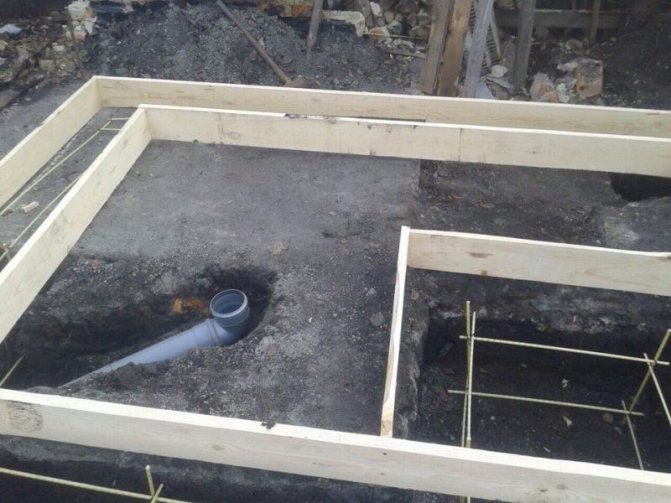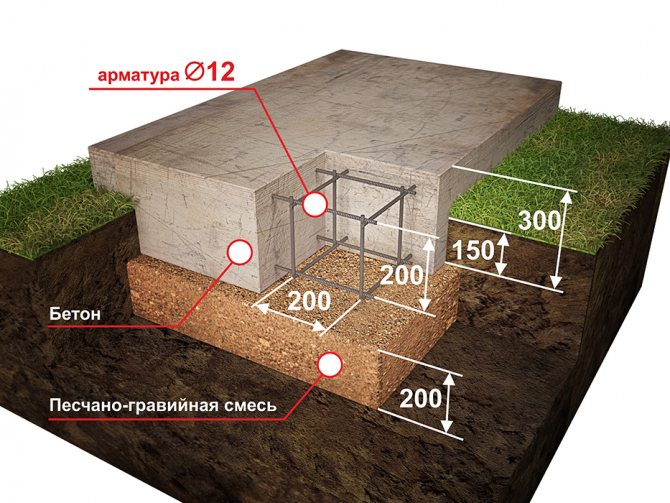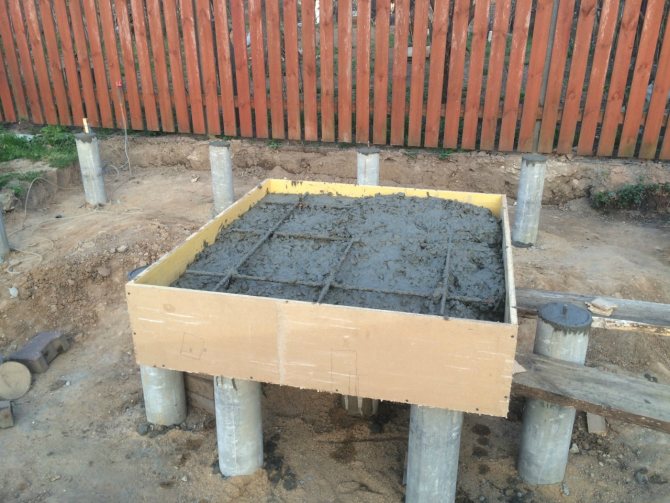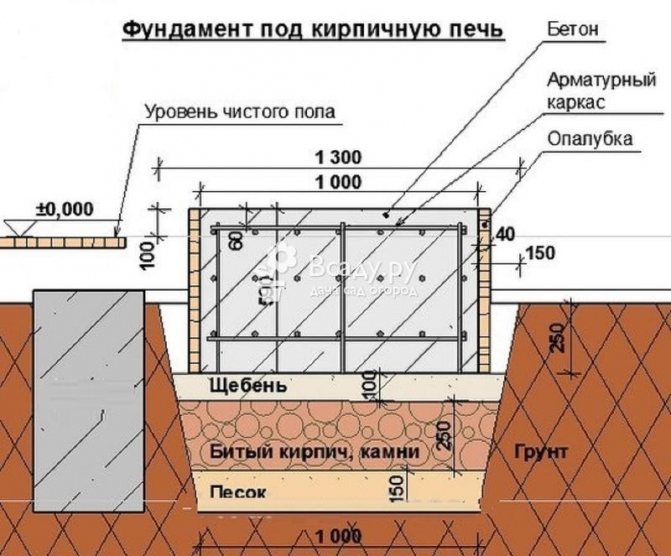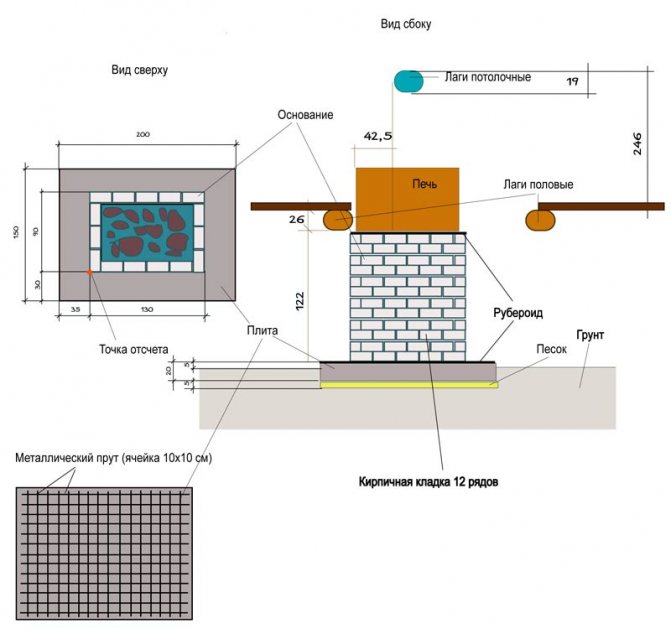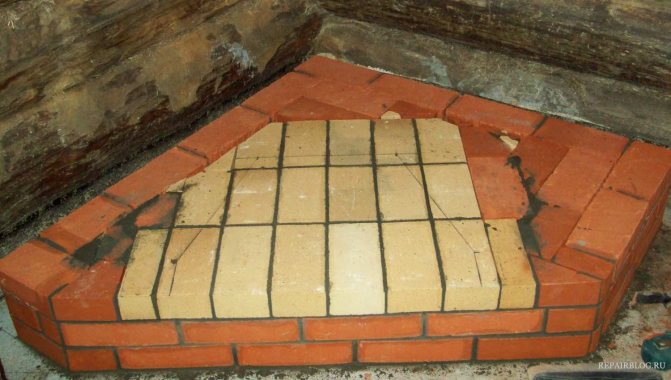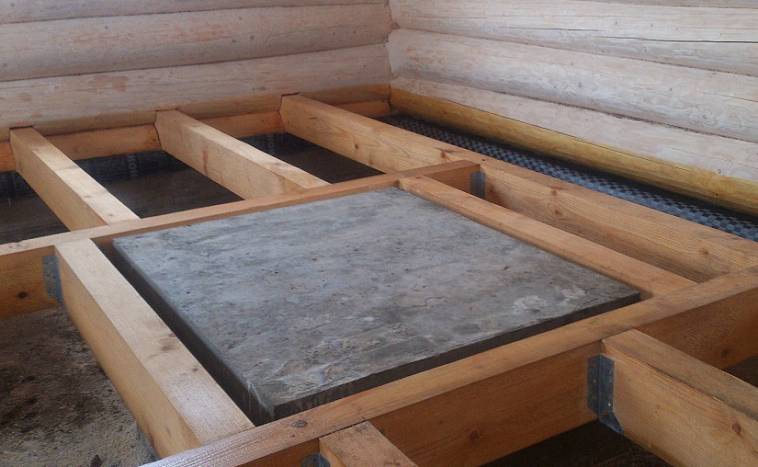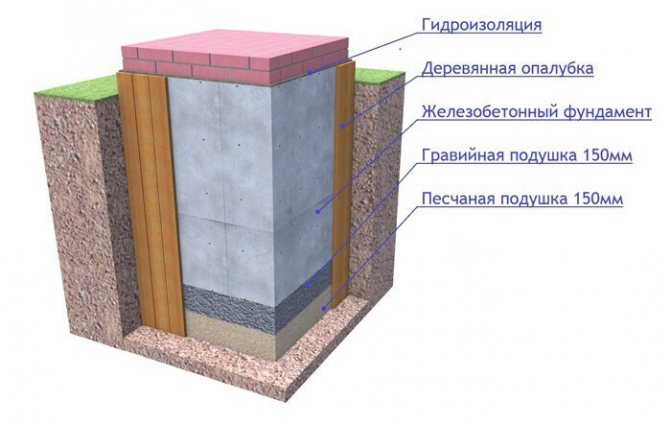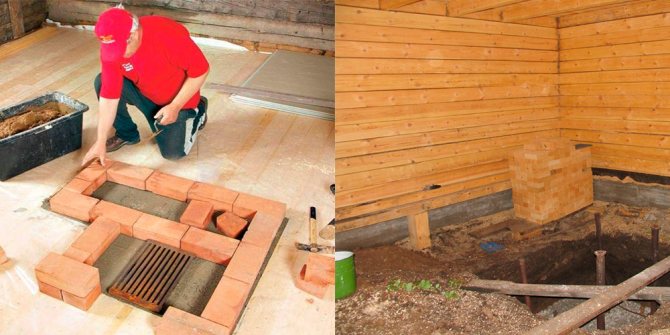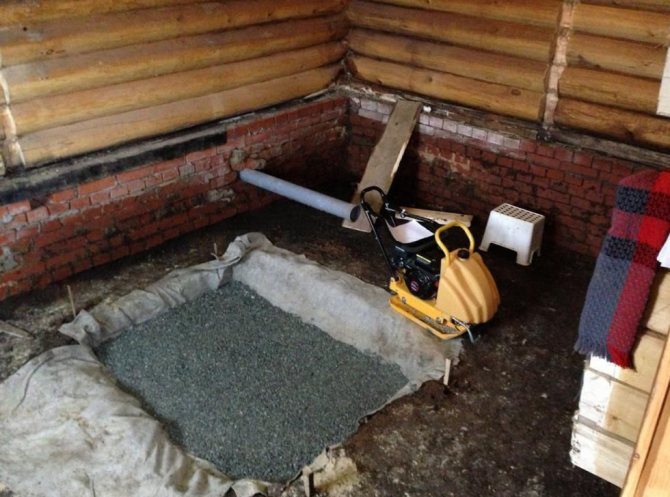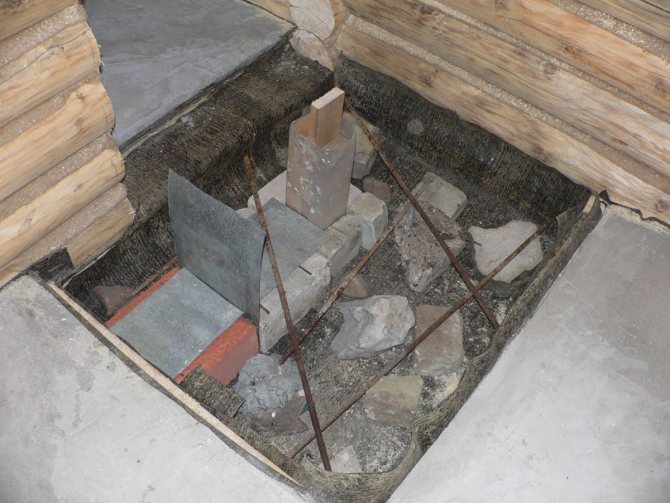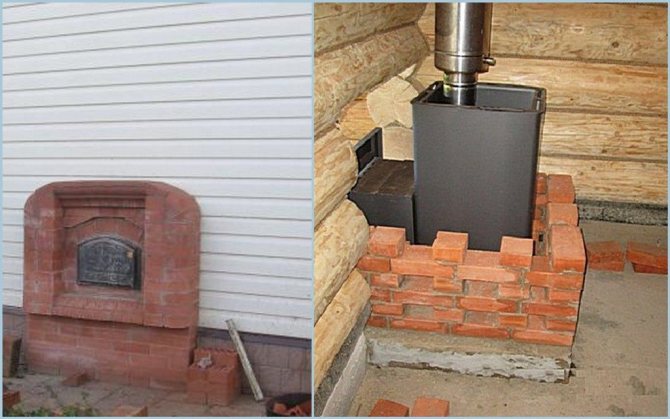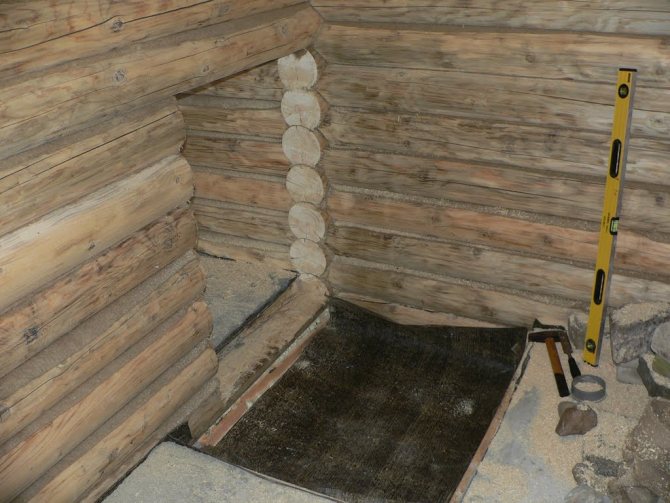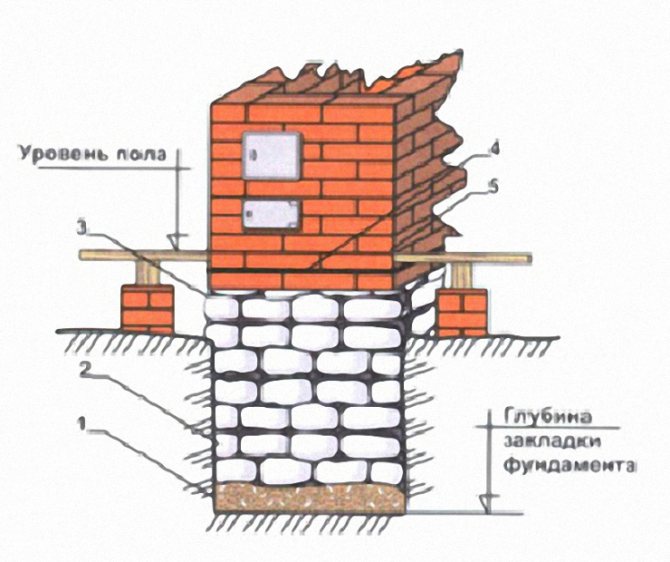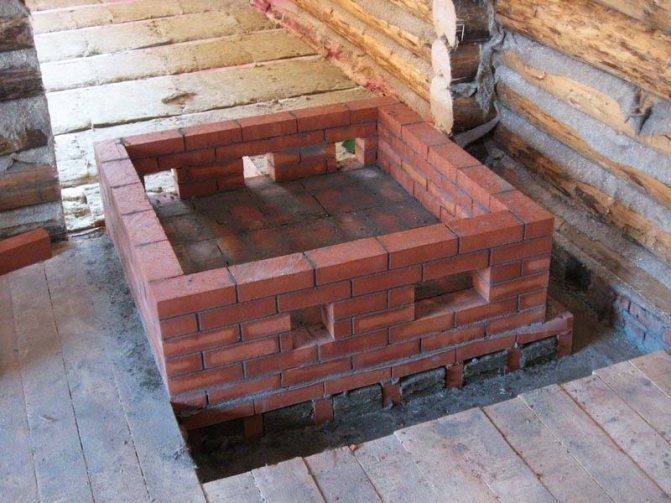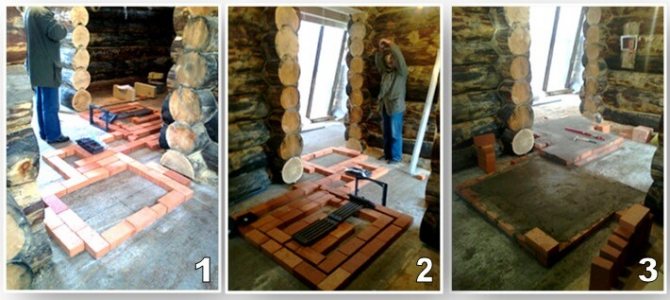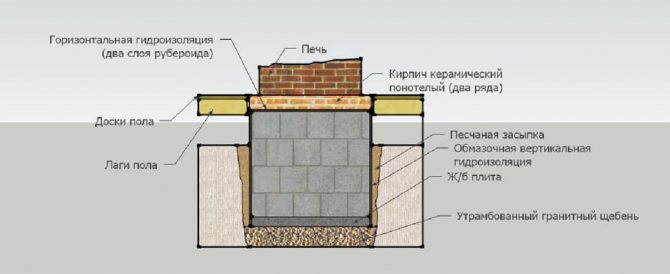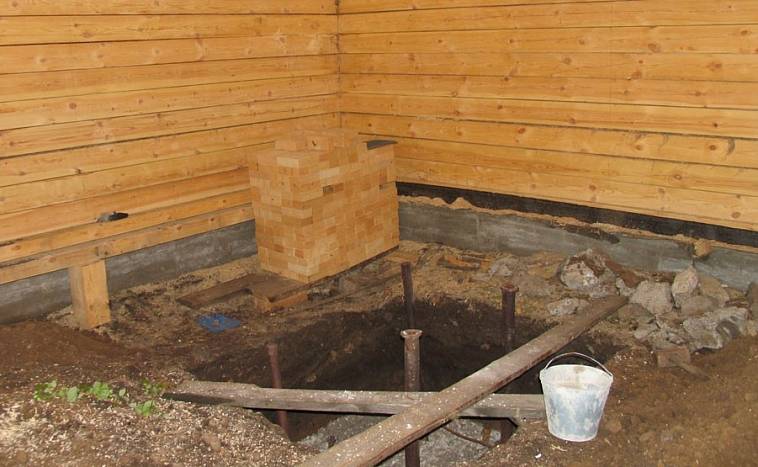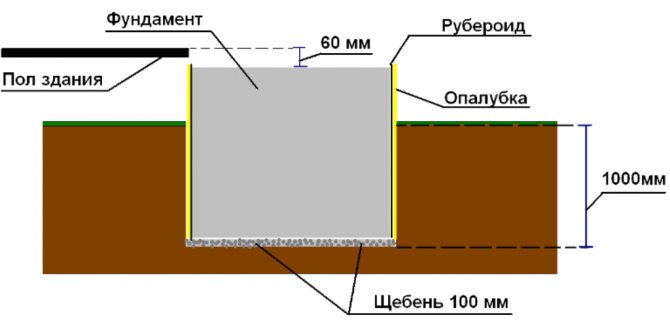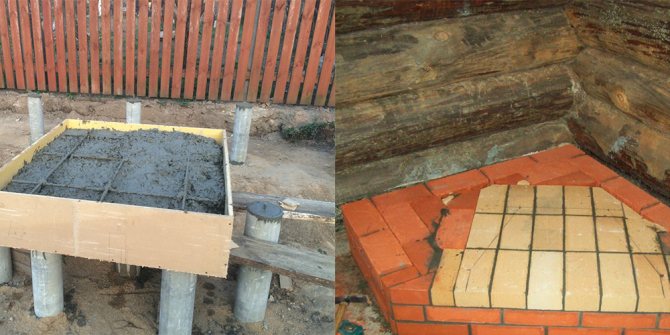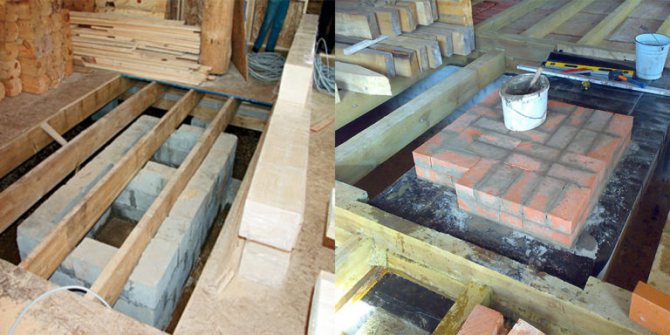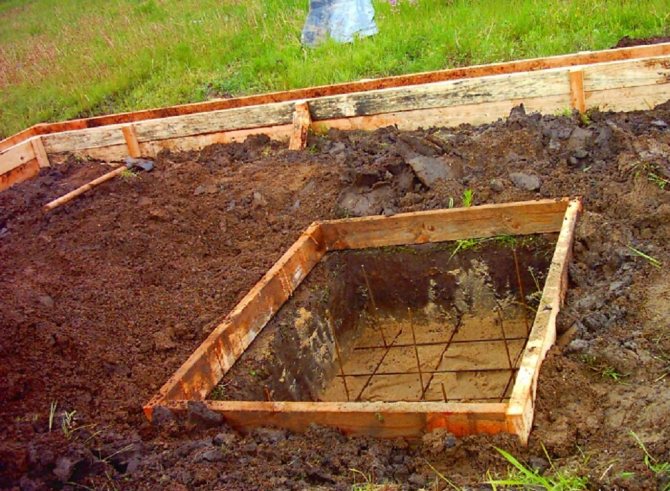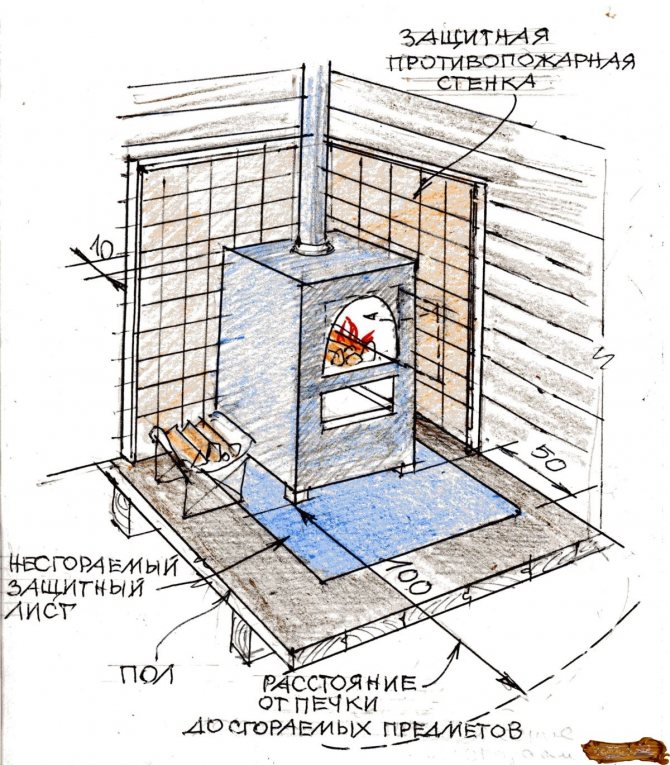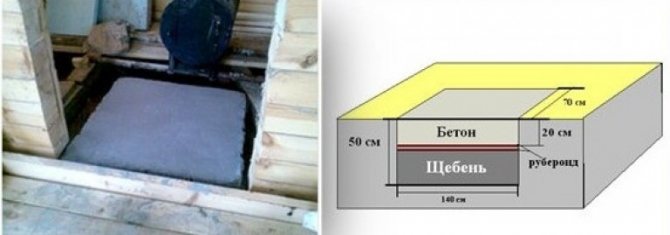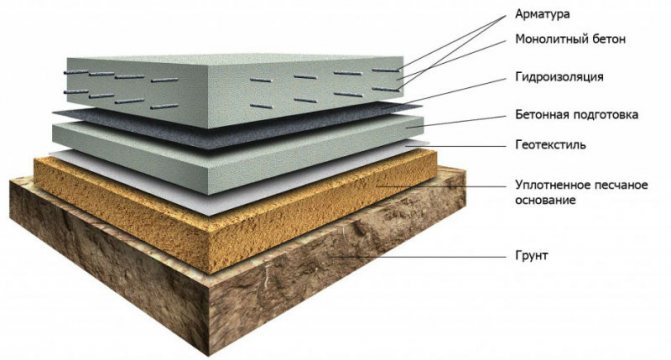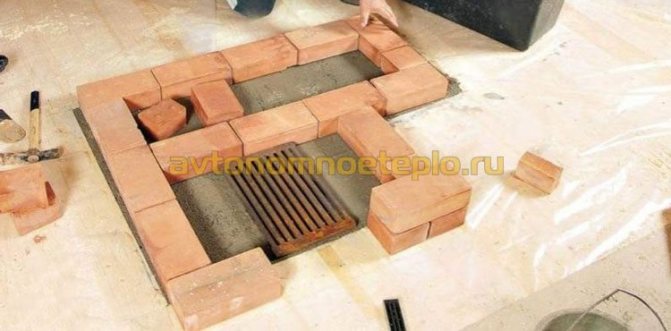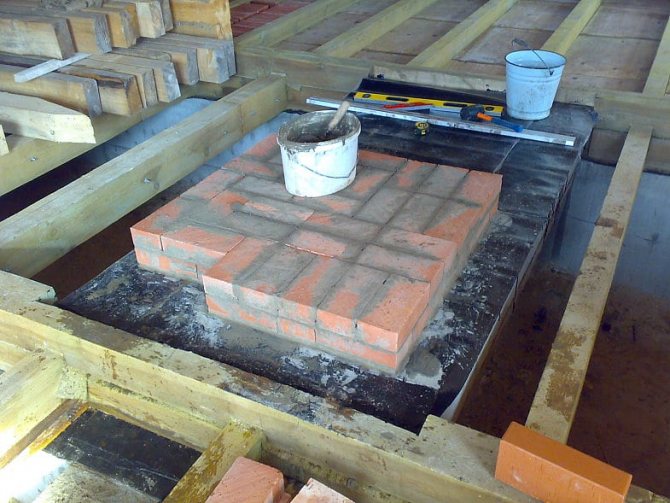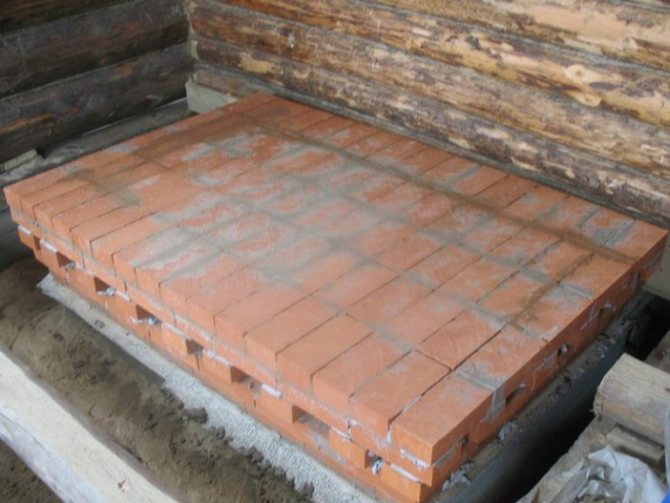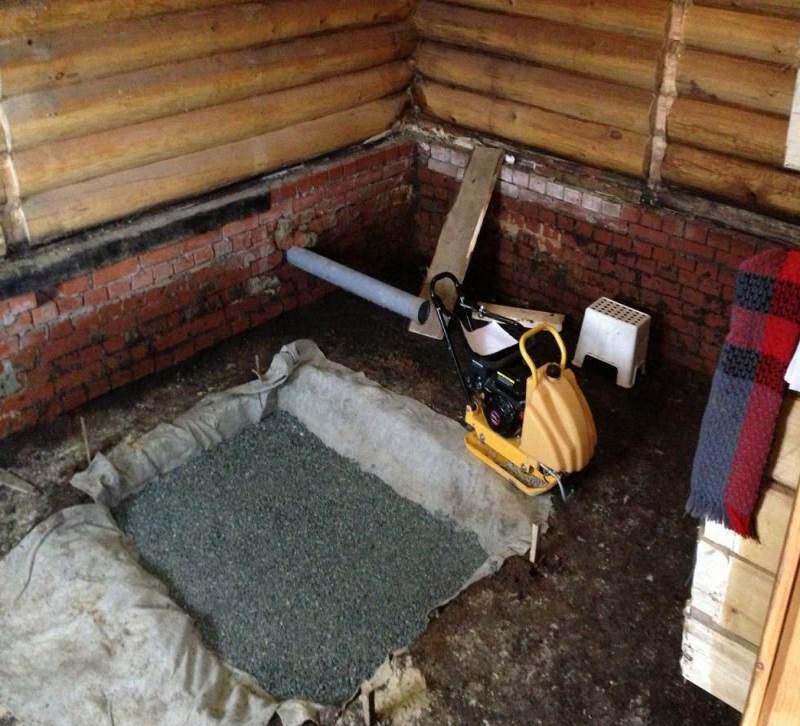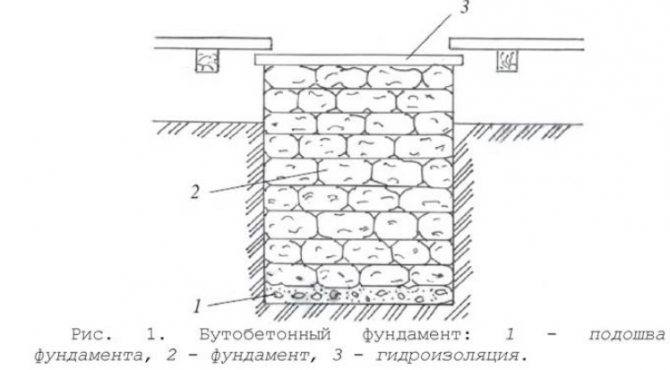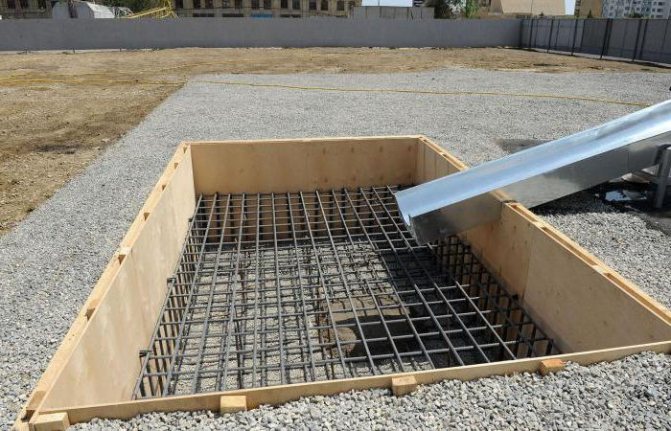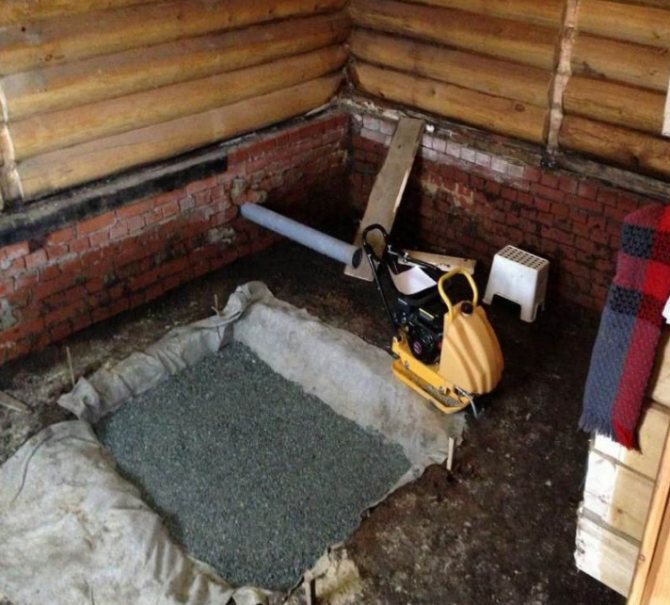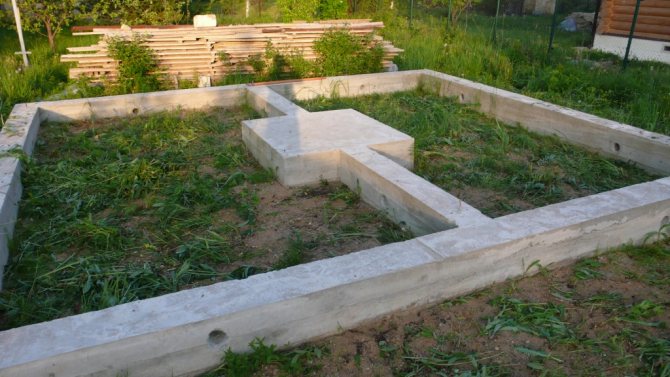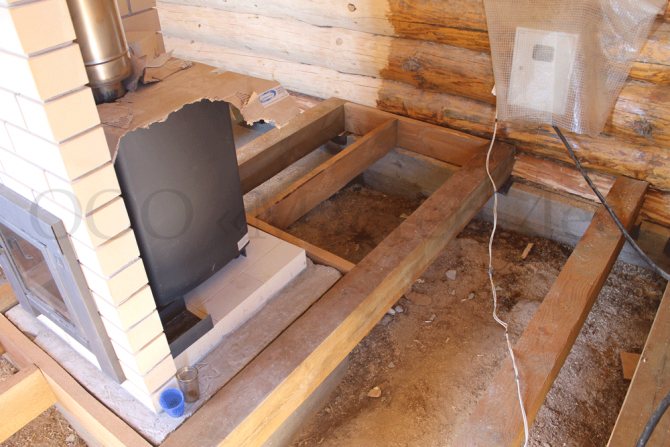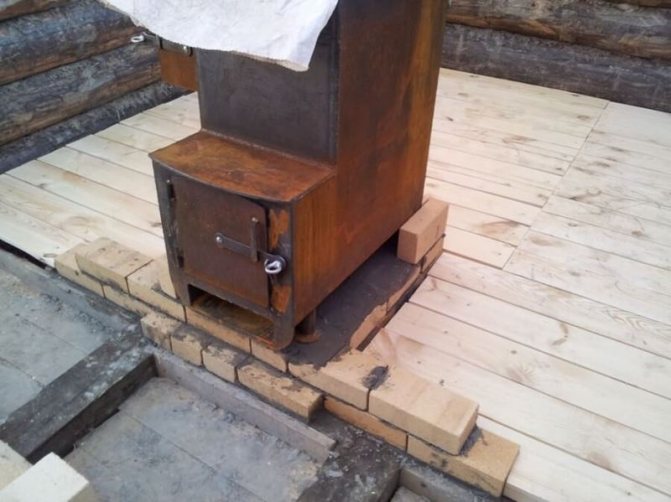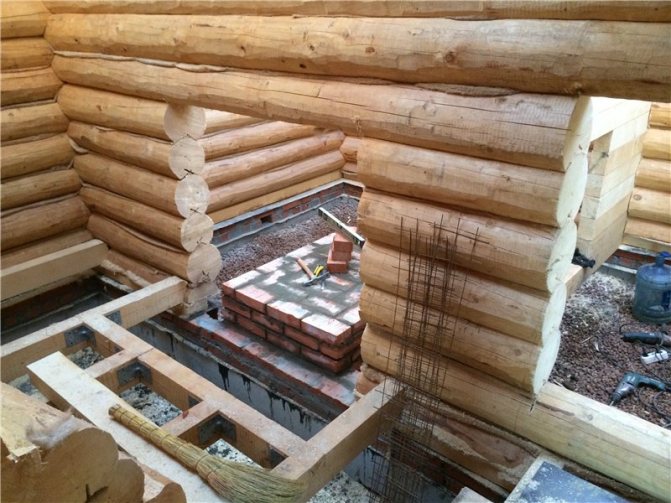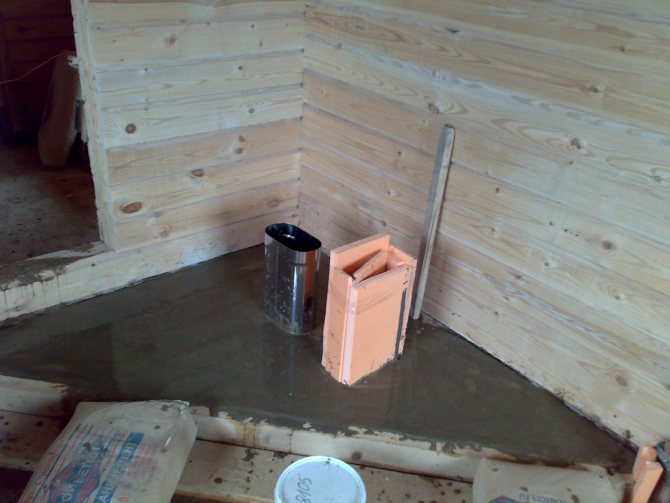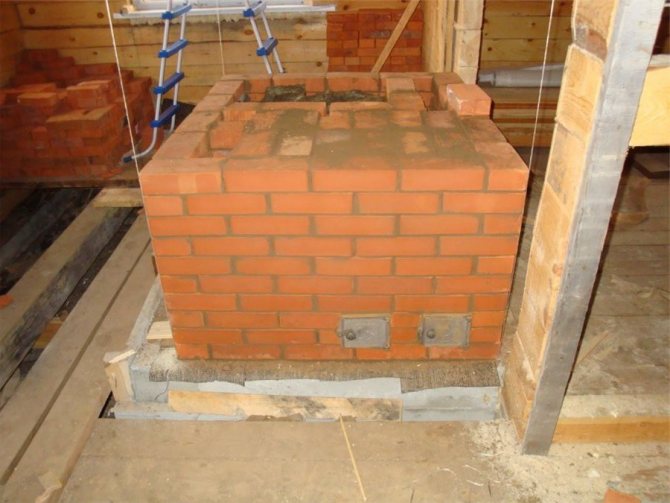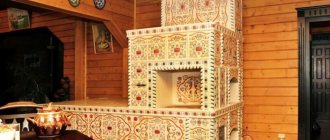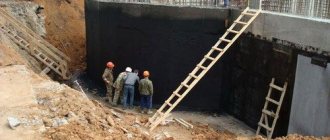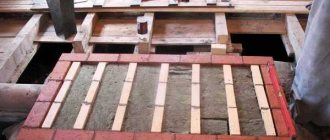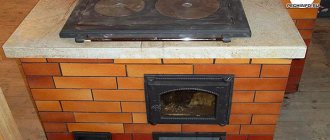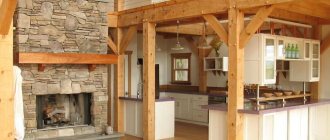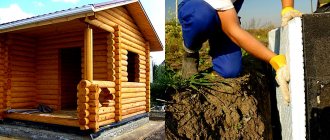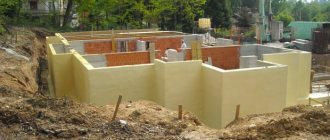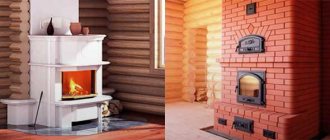Types of foundations for a stove in a bath
The base for the sauna stove is a must. This is due to the fact that a metal or brick stove exerts a significant load on the floor in the bath. Lack of a solid base will deform and destroy the floor structure and the oven itself. Therefore, in parallel with the main foundation for the bath, it is necessary to think over the arrangement of the base for the stove.
In most cases, the following types of foundations for a bath stove are used:
- The monolithic concrete base is considered the most popular, it is poured simultaneously with the main foundation or as a separate structure. The depth of laying such a base for a bath stove should not be large, therefore, in most cases, a bedding is made of sand, rubble or rubble.
- The brick base is also a monolithic slab, lined with several rows of bricks. The strength characteristics of such a foundation are at a high level, like that of a concrete foundation, but with some advantage. In particular, we are talking about the possibility of dismantling if necessary. However, it should be borne in mind that on problem soil prone to seasonal movements, the integrity of such a foundation may be violated.
- The columnar foundation can be called a rarity, it is erected in the case when the above options are not suitable.
Column foundation
If you want to reduce the amount of excavation and materials used, then you can make a foundation for the furnace using a columnar structure. As a base, you can use a frame, which is made of a steel profile or a reinforced concrete slab. Piles or pillars, which act as a solid support, are mounted in pre-prepared holes. Next, the base is installed, which is attached to these supports.
The columnar furnace foundation does not care about heaving and seasonal movements of the soil. This is the most durable base for the oven.
The foundation for the oven - warnings, advice on choosing, instructions for work Video
Zero cycle works traditionally consume 25-30% of the total construction budget. A lot, right? But saving is not appropriate here, since a healthy "root" is the key to the integrity of the whole "plant".
The foundation for the furnace is made in the form of a solid base plate, and it should not be connected to the base of the building itself. But its depth depends on three main factors:
- the height of the aquifer;
- type of soil;
- the level of soil freezing.
All these data are obtained during geological exploration of the site, when specialists, by drilling control wells, obtain soil and water samples and make appropriate analyzes. The procedure is paid (from $ 50), so many homemade products run the risk of building "by eye" or are guided by folk methods (for example, a willow frame). It is not always possible to guess, therefore, a weak foundation for the stove shows its "dissatisfaction" with such symptoms:
- Through cracks in the housing.
- Partial destruction of individual parts of the masonry.
- Violation of the integrity of the chimney.
The main feature of the listed defects is that the breakdown cannot be repaired. After the restoration of the furnace, cracks and collapses are repeated, which directly indicates an incorrectly laid foundation. Here you remember with a "kind" word about your pseudo-economy - but it's too late. It is impossible to carry out "sparing" repair of brick stoves with a weak foundation. We'll have to completely demolish the unit and redo it again.
For those who are afraid of the complexity of zero-cycle work, it is useful to remember how hard our ancestors worked on this stage: they prepared massive logs and manually adjusted them to each other in order to achieve the correct support for their “wet nurse”.
Now in the homemade arsenal there are two available ways to get a strong foundation for a brick oven:
- Assembly of the slab. Small reinforced concrete blocks or ceramic bricks are used as building materials.
- Pouring the slab. The base is formed from concrete mortar, into which a rigid frame made of river rubble or iron reinforcement is introduced.
The monolith also has disadvantages: the slab must stand at rest for at least three weeks. In principle, such a delay in construction is not a problem. For example, if the foundation for a sauna stove is being set up, then during a technical pause, the builders are engaged in finishing work in the steam room.
To describe the progress of the work, we chose a monolithic furnace foundation, reinforced with reinforcing rods, since this type of base is the most popular among homemade people. Remember, the base plate should be 5 cm wider than the stove body.
- We are preparing a pit for the foundation. The dimensions of the pit are additionally increased by another 15-20 cm. This margin is needed for the correct laying of the formwork and the filtering side layer of crushed stone, bricks and sand. The depth of the pit is calculated according to geo-prospecting (an allowance for filtering “cushions” is added).
- We lay the sand "pillow" under the foundation. A 15-centimeter layer of sand is poured into the bottom of the pit, which is carefully tamped. To prevent shrinkage, it is spilled with water until the level of the backfill stops dropping. In the process of tamping, sand should be poured to the desired level.
- We lay the crushed stone filter for the foundation. A 20-centimeter layer of rubble is poured onto the compacted sand, mixed with brick fighting and medium-sized stones. The stone "carpet" is lightly sprinkled with a sand mixture to fill the voids formed in it. For better sand penetration, water is also needed. Then lay out a 10-cm layer of finer gravel and cover the resulting filtering "pillow" with a double layer of roofing material.
- Formwork installation. A solid plywood (or plank) "fence" is installed along the perimeter of the pit, which is reinforced with a support every 50 cm. There must be at least 10 cm of free space between the edge of the pit and the formwork.
- Reinforcement mesh tab. The bottom of the pit is poured with concrete (starting layer 4-5 cm), which will serve as a support for the "skeleton" of the foundation. As soon as it grabs, pre-connected reinforcement meshes are placed in the pit (there are ready-made sets on sale).
- Pouring solution. Concrete is prepared according to the following proven proportion: cement - 1, sand - 3, crushed stone - 5 and water. Before pouring the solution, the formwork is thoroughly moistened in order to prevent the absorption of water from the concrete by the tree. The working mixture is poured in layers (20 cm each), gradually reaching the zero mark of the plate. Each layer is carefully knocked out with a hoe to expel air bubbles from the solution. The top of the slab is carefully leveled and, after the first setting, is covered with a tarpaulin (roofing felt).
During all three weeks, the stove foundation should be hidden from the sun and periodically moistened.
Application area
Wasted heat can be used for two purposes:
- to heat the water to be used for washing;
- for space heating.
Of course, such goals can be combined if the stove is powerful enough. After all, we, in fact, will take away some of the heat that would otherwise be used to heat the steam room (or the atmosphere)).
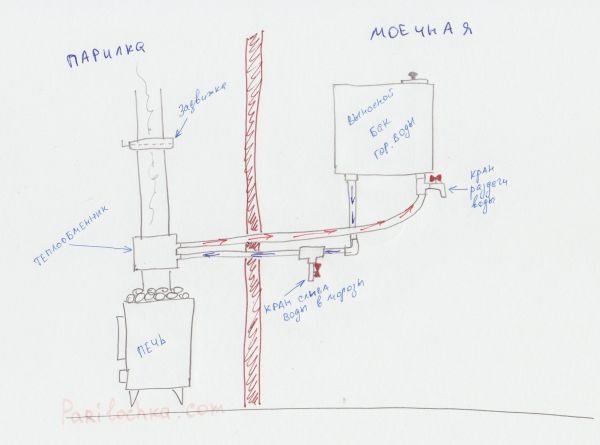
Scheme of heating water in a remote tank with a samovar-type heat exchanger (for a video explanation, see below)
This is the first time.We are talking exclusively about water (no antifreeze), the consumption of which depends on the number of people who can wash in the bath at the same time and other factors. In any case, you cannot do without a spacious tank. And here you again have options for where to place it:
- some place the tank directly on top of an oven, which must be designed accordingly. Water is supplied to the washing room from the steam room;
- others use a heat exchanger, and the tank itself is placed in an adjacent room, from where it communicates with two pipes with a heat exchanger.
Both designs of stoves with a tank have the right to exist, and the choice is yours.
If, instead of a tank, you connect a heat exchanger with a radiator, you get an autonomous heating system.
And here you again have two options):
- or create a structure that is based on phenomena such as convection and gravity;
- or to force the coolant to move forcibly in the system - this will require a pump, and therefore electricity (! a separate section is devoted to electric stoves).
If the bathhouse is small, then there is no need to bother even with the simplest system, because usually the stove is enough to heat adjacent rooms. But what matters here is what kind of winters you have. It happens that a small bathhouse needs additional heating.
It was already mentioned above that it is possible to combine heating water for washing and heating. In fact, you can make two parallel systems, and for heating not water, but antifreeze. For this purpose, one heat exchanger will need to be placed inside the furnace, and the second on the chimney. From the point of view of increasing the efficiency of the furnace, the option is just excellent.
On a note! When creating a heating system, do not forget about the expansion tank, which will take over the excess coolant.
Concrete foundation
- Coarse sand without inclusions. The ideal option would be to use mountain sand, but sea and river sand are also suitable. We have already considered the methods of cleaning sand from impurities on the pages of our Internet resource.
- Formwork material.
- Crushed stone.
- Roofing material or dense polyethylene.
Instruments:
- Solution trough
- Shovels: bayonet, shovel
- Building level
- Hammer, nails, hacksaw for formwork construction
- Construction stapler
You can start building the foundation for the stove. Many people may wonder whether it is necessary to go deep into the ground when the foundation is being built with their own hands under the stove. Our answer is obligatory. Sometimes there is an option in which the foundation is arranged with a shallow depth. Only the upper vegetation layer is removed and after the installation of the formwork, the foundation is poured.
Digging a pit
For dry, sandy soils, 500 - 600 mm is enough. But on heaving soils, this depth should not be less than 1000 mm. We repeat - this is the correct foundation.
Correct laying of the foundation
We dig a foundation pit according to the markings. The size of the pit must allow the installation of the formwork. But if the soil on your site is dense enough and the edges do not crumble, you can do without it. In any case, it all depends on the specific location and soil. When the formwork is installed, a layer of crushed stone 100 mm thick is poured onto the bottom of the pit. Crushed stone must be leveled. After that, it is necessary to compact the crushed stone with a manual rammer.
For waterproofing the foundation, a layer of roofing material is attached to the inner side of the formwork using a construction stapler. You can start pouring
It is important to know that the upper level of the foundation should be 60 - 70 mm lower than the main floor of the building. We prepare the solution in the following proportions:
- Cement 1 part
- Sand 3 parts
- Crushed stone 5 parts
Solution
- First, a dry mixture of cement, sand and crushed stone is prepared. You can use mortar for laying the stove.
- After shoveling and obtaining a homogeneous mass, water is gradually added until a solution of the consistency of thick sour cream is formed. The solution can be poured.
The use of a concrete foundation can significantly save on mortar. Consider a variant of such a foundation.
Concrete foundation
Preparation of the pit is performed in the same way as in the first case. After the crushed stone is filled up and rammed, the first layer of rubble is laid on the bottom. Mortar for rubble concrete mix:
- Cement 1 part
- Sand 3 parts
- In this way, the entire filling is performed.
- It is not allowed to pour several layers of rubble stone at the same time. In this case, voids are formed inside the foundation, which reduce the characteristics of the foundation.
The foundation is poured. It is necessary to carefully level its surface and check with a building level.
- The foundation will dry out for ten days. In the first week, it is necessary to spray its surface with water.
- If you do not have the opportunity to be on the site all the time, proceed as follows: after pouring the foundation, cover the foundation with plastic wrap and leave it in this position for a week.
- After seven days, the film must be removed and the foundation left for another 5 - 6 days.
How to make a foundation for a stove
The foundation for the stove in the house, made of metal, is performed according to the following technology.
Consider:
- A pit is pulled out and sand is laid with a thickness of 30 cm, which is carefully compacted;
- One layer of mortar is poured, which cools down during the day and serves as a sole for the base;
- Waterproofing with roofing felt;
- It is poured with concrete mixture and the horizontal level of the surface is checked by the building level. The resulting foundation is characterized by increased reliability and strength.
Experienced craftsmen advise making a base even for a furnace made of sheet steel, even though they weigh no more than 150 kg. Stages of work:
- First, they dig a small hole 50-60 cm deep.Crushed stone is poured into it and tamped so that the depth of the layer does not exceed 30-40 cm.
- Cement mortar is poured over the rubble. Its consistency should be medium, that is, not too thick and not too liquid. The ratio of the components is cement (1 part), sand (4 parts), water (1 part). The pit in this form is left for 24 hours so that the cement slurry has time to harden.
- Next, sheets of roofing material are laid out on the cement surface. This is the waterproofing of the base.
- After that, the pit is poured with a concrete solution of fine gravel, cement, sand and water in a ratio of 4: 1: 2.5: 1.
Some masters advise laying out a brick foundation. This method will cost a little more, but making a brick base is much easier. To do this, you do not need to knead the concrete solution and buy additional sand and gravel.
The following publications will perfectly complement this material:
Regardless of what kind of oven you plan to build in the house, a barbecue oven or a traditional Russian one, you will not be able to do without a reliable basis in any case.
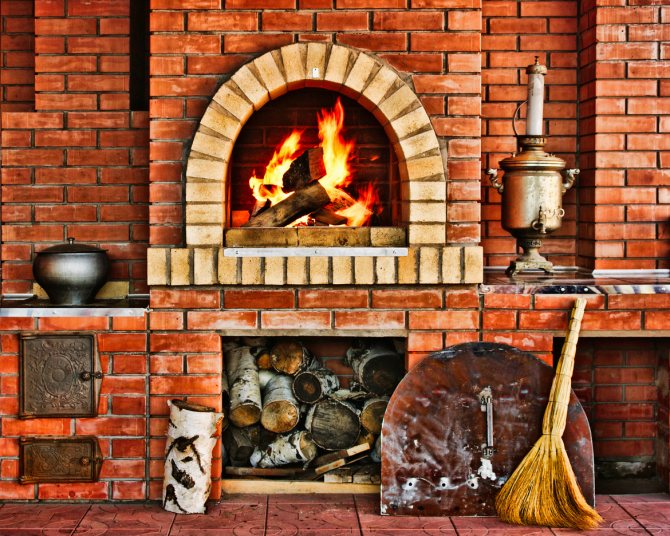

If you plan to install a metal barbecue oven, you can make the foundation with your own hands as follows:
- dig a pit;
- fill the bottom of the pit with sand or gravel with a layer of at least 30 centimeters;
- tamp the crushed stone thoroughly;
- pour the compacted crushed stone with cement mortar;
- wait for the cement mortar to dry (on average, it takes about a day).
In order for the foundation to be reliable, the proportions of the sand-cement mixture should be carefully observed. Usually it is four parts of sand, one part of cement and water. After the composition has hardened, a heat-insulating material should be placed on the base. Most often it is roofing material.
As for the cement-sand mortar, to fill the foundation for the stove, it should be made as follows.Ordinary filling cement (it is recommended to make a choice in favor of grades 300-400) is carefully sieved through a special sieve with 1x1 mm cells. The sand is also sieved.
The laying of the base for the Russian stove must be approached especially thoroughly. After all, we are talking about a rather heavy and oversized design. As a basis for such a structure, a rubble concrete foundation or a foundation on screw piles that can be made by hand is most often used.
Reinforced concrete slab as a foundation
To make a concrete base, such as in the photo, for a fireplace you will need:
- sand;
- crushed stone;
- Portland cement;
- waterproofing materials;
- formwork panels;
- armature for reinforcement
The sequence of work is as follows:
- They dig a pit, into which a reinforcing mesh with a mesh size of 10-15 centimeters is laid.
- The pit is filled with a solution, for the manufacture of which they take 1 part of cement and 4 parts of gravel. It is advisable to divide the filling into 2 stages. It will take about two days for the concrete to harden.
- In order to avoid the harmful effects of the sun's rays in hot weather, the concrete is covered with roofing material.
- To improve the quality indicators of concrete, after dismantling the formwork, its surface is moistened with water. Formwork sheets are removed in the summer after 5-7 days, and in the winter after 10-14 days.
- If the finished concrete base has defects, special waterproofing measures are taken. For such work, special compositions are used, the components of which depend on the indicator of the amount of groundwater. If they are completely absent in the soil, waterproofing is done using sand and cement in a ratio of 1: 1 or 2: 1.
- At the end of the work, the pit is covered with non-porous soil.
Foundation made of rubble concrete
The foundation pit should be 10-15cm wider. A layer of gravel is poured onto its bottom and then it is tamped tightly. Then they begin to manufacture the formwork from the boards and place it around the entire perimeter of the pit. The walls of the formwork are sheathed with roofing material, then the base is covered with a layer of large stones. The resulting voids between the stones are covered with fine gravel. A cement mixture of the consistency of thick sour cream is prepared and stones are poured with it. If the pit area is large enough, then the work must be carried out in several stages.
First, let the first layer of stones and concrete dry, and then continue working. The pouring should be stopped when about 5-7 cm remains to the floor level. Using a level, check the evenness of the surface. Then the entire base of the foundation is covered with plastic wrap and left to harden for a week.
After everything is dry, the formwork should be dismantled. The tar is melted and applied in two layers to the base of the foundation. The resulting gaps between the walls and the base are covered with sand or gravel.
Construction errors and their consequences
When erecting the furnace foundation on your own, you can expect the appearance of various errors. The most common errors include those listed below:
- The main mistake is that, quite often, there is no working documentation on the foundation. It is unacceptable to skip or ignore the design stage. Otherwise, all the work and the costs associated with them may turn out to be meaningless.
- The work should only be carried out by a qualified builder who already has experience in performing such work. A worker without any qualifications, most likely, will not be able to perform work in strict accordance with the set technical requirements.
- Another miscalculation that developers make is the start of construction, without a detailed analysis of the soils located at the construction site.Without this information, it is impossible to calculate the area of the foundation, choose the right place for the supports and choose the optimal type of furnace base.
- The construction of the foundation cannot be carried out without an accurate knowledge of the depth of the foundation. Often, this parameter is calculated based on past experience. In order to avoid such unpleasant situations, it is necessary to study the characteristics of the soil and constantly check the data with the design documentation. It should be remembered that any foundation must be based on soil, which has not destroyed the structure.
- Sometimes, during the construction of foundations, the developer retains the topsoil. It is unacceptable. It must be removed, and it must be deepened by 150 mm.
- A wrong choice of a foundation foundation will certainly lead to unpleasant consequences. Up to the complete destruction of the structure.
Sauna boilers
The modern construction market offers a very large selection of boilers for heating a bath. For this reason, before buying a particular model, it is advisable to get professional advice in advance. So you can study all the design features of the bath and you can make the right choice.
If the bathhouse was built from foam blocks, then the boiler is placed in a special room. The air temperature in it should not exceed the temperature in the steam room itself. Be sure to monitor the humidity level. For safety reasons, this room should be free of trash, clean and well ventilated.
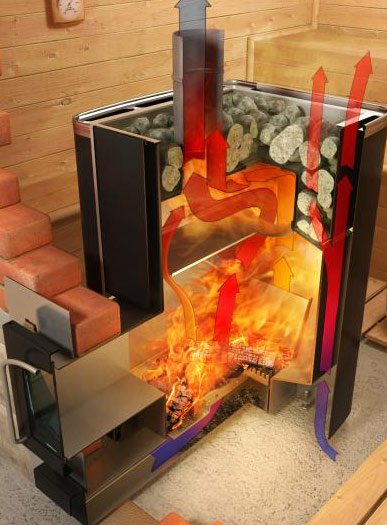

The principle of the sauna boiler
The heating boiler is chosen depending on what kind of fuel will be used. The gas model is ideal if natural gas is supplied to the house. Diesel or solid fuels are quite expensive.
The most profitable options in such cases will be firewood, peat and coal, but they have one definite drawback: when using them, you need to constantly clean the boiler from pollution. The biggest advantage of a diesel engine is that thanks to it, the boiler runs smoothly for a long time.
Now manufacturers offer boilers that run on two types of fuel at the same time. However, their level of efficiency is still low. For this reason, it is better to purchase a standard boiler that runs on one type of fuel.
If gas is supplied to your site, then, without a doubt, one of the best heating options will be the use of a gas boiler, because in this case you will not have to think about purchasing fuel.
In addition, you will be spared from problems with unpleasant odors and soot (if you smell gas, call a specialist immediately: your boiler is damaged). The gas boiler itself is small, so it takes up very little space. Its weight does not exceed 50 kg, and its power can reach 40 kW, thanks to which a small boiler can easily heat a room with an area of 300 m2.
Electric boilers for a bath are environmentally friendly. They do not need to be equipped with a ventilation system and fuel supply, in addition, they can be easily adjusted to the required air temperature. Perhaps the only drawback of this type of boilers is that they consume too much electricity.
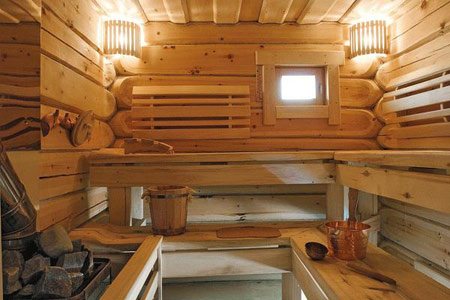

Solid fuel boilers can maintain the required temperature in the steam room for a long time, but at the same time they are not able to do this automatically, since they need timely fuel supply. In addition, it is necessary to clean them from time to time.
Boiler manufacturers are constantly inventing all sorts of innovations designed to increase the safety of boilers, their efficiency and reliability, as well as ease of use.The heaters are installed in such a way that it is possible to extract maximum energy with an even distribution of fuel combustion. Most modern solid fuel boilers have cooling circuits that protect the device from overheating.
Solid fuel boilers are conventionally divided into two types, the first of which includes products from cast iron, and the second from steel. Naturally, each of these groups has not only certain advantages, but also disadvantages. Cast iron models have a high level of reliability, but at the same time they are not too resistant to sudden changes in temperature, which can be in the bath in winter. Steel models have a much higher inertness of the heat exchanger, but they gradually deteriorate due to corrosion.
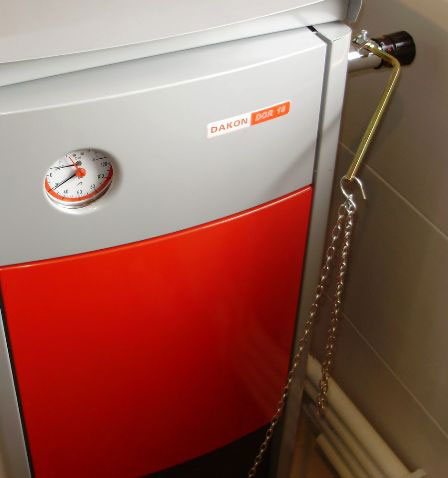

Mechanical thermostat
Solid fuel boilers are equipped with electronic or mechanical thermostats, the former often being supplemented by fans. Modern boiler models can operate autonomously for three days (if there is enough material in the fuel supply hopper).
A solid fuel boiler for heating a bath can be made with your own hands. Fortunately, the drawings of the simplest models are so easy and understandable that anyone can figure them out. However, remember that to ensure the longest possible service life of the device, you will still need to consult a specialist.
Immediately after gas boilers, diesel boilers follow in popularity. When using such models, there will be no unnecessary hassle with storing fuel, you just need to build a simple plastic or metal container with double walls for reliability. In some cases, diesel fuel is stored in special tanks that are buried in the ground.
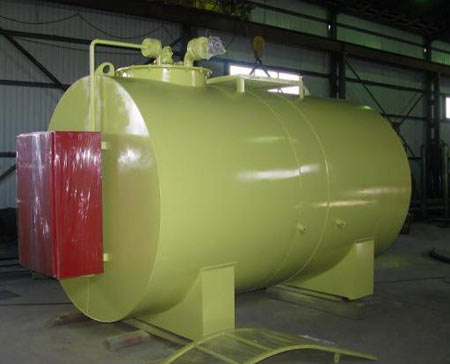

Tank for storing fuel in the ground
To arrange such a storage, it is advisable to turn to the services of specialists, since self-installation may be unsafe.
It is important to know that diesel fuel cannot be stored for a period longer than one year. It is possible to install a boiler on diesel fuel only in a separate room, since the smell of diesel fuel is quite unpleasant and harmful to the body.
This boiler consists of two combustion chambers for fuel. In one of them, primary combustion occurs and gas is released, and in the other, the fuel is already burning out and gas is synthesized. Such a boiler is melted using a special electrical system.
However, it also has disadvantages - these are high cost and complexity in operation. So, wood for kindling must be dried, since material, even with low moisture content, will not work.
Pyrolysis boiler combustion chamber design
Long-term combustion boilers for solid fuels have long combustion times for a separate loaded batch of fuel, in some cases, the times can be up to 5 days.
The video shows step-by-step instructions for making a long-burning boiler with your own hands
Firewood, sawdust, coal or peat are usually used for heating. The principle of operation is simple: depending on the speed with which the fuel smolders, the air supply mechanism periodically comes from above from above. Thanks to this, the boiler maintains a sufficient temperature for you and automatically changes the air supply due to the draft regulator, which allows you to control the combustion level.
Support-pile foundation for the furnace
This is one of the most modern and effective ways to build foundations. This option is great for both a bathhouse and a wooden house.
The essence of the method lies in the fact that a reinforced concrete slab 15-20 cm thick is installed on piles or columnar supports - this depends on the depth of soil freezing.
Installation of such a foundation is extremely simple:
Holes with a diameter of about 20 cm are drilled to the required depth in the ground. At the bottom, crushed stone is poured with a layer of 10-15 cm thick. The layer is well rammed.Further, pipes made of roofing material are inserted into the pits, they serve as formwork. Concrete mix is poured into them. All this is left to dry for a period of 14 days.
As soon as the pillars fully gain strength, a reinforced concrete slab is installed. On the upper edge, waterproofing is carried out using roofing material. The surface is lubricated with hot bitumen or cold mastic, roofing material heated by a burner is laid on top.
Pile option
Sometimes it is easier to install a concrete slab on piles than to pour it into the ground. Both options are comparable in terms of labor intensity. But in the first case, the foundation will be more expensive, since materials for the construction of supports will be required. It can be concrete or brick pillars, screw piles.
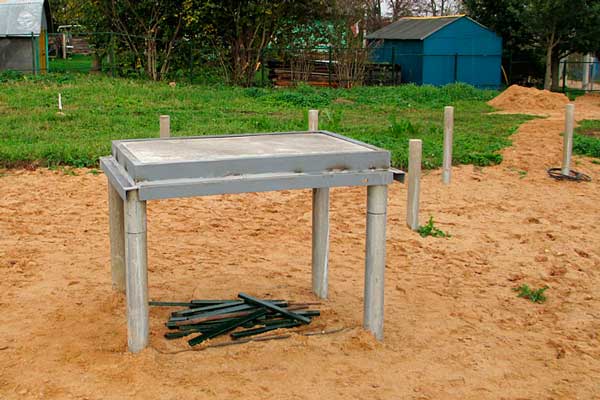

The supports are poured on their own, using large-diameter metal pipes as formwork. The soles of the pillars are installed at a depth below the freezing point of the soil by 20-30 cm.
Watch additional video:
The upper ends of the piles should be located in the same horizontal plane. At the final stage of work, a slab of such a thickness is installed on the supports so that it can withstand the expected weight of the furnace. Following all of the above rules will help build a solid foundation.
Materials and tools
Tools for arranging the foundation of the stove
Before starting construction work, first of all, you will need to stock up on tools that are selected individually for each stage. For excavation and carpentry operations you will need:
- shovel-bayonet for preparation of the pit;
- shovel-scoop for mixing the solution;
- two sample sieve: for sifting cement and sand;
- a hammer.
It is necessary to prepare a metal trough or other container for the solution, as well as a tape measure, a pencil, a building level and a mounting stapler. From a set of building materials you need:
- boards going to the arrangement of the formwork;
- polyethylene for waterproofing;
- sand, dry cement and selected gravel.
To strengthen the foundation, you will need reinforcing mesh or iron bars.
How does a heat exchanger installed in a sauna stove work?
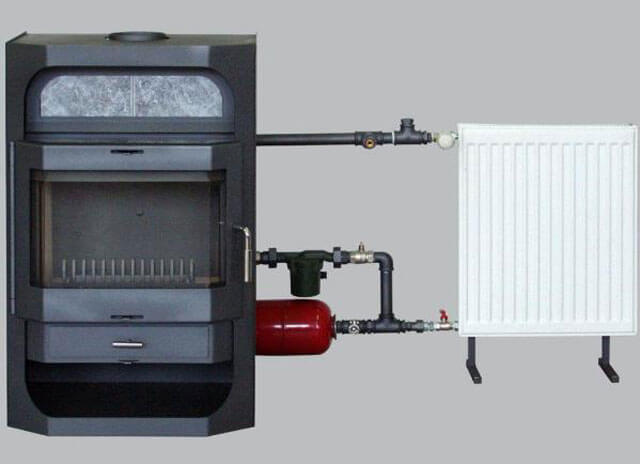

The device of the furnace with a heat exchanger has proven itself so well that various options for the design of heat removal have appeared, with varying degrees of efficiency. The most common:
- Classic coil.
- Built-in flat heat exchanger (similar to two hollow trays connected to each other).
- Samovar heat exchanger installed on the chimney.
The water jacket surrounding the combustion chamber is used extremely rarely and is found in only 1-2 models of factory-made furnaces.
Meanwhile, sauna stoves with a heat exchanger have become the subject of consumer discussions. Some argue that the application is not practical, others, on the contrary, indicate convenience and comfort during operation.
What does a built-in or samovar heat removal device give?
- A heat exchanger in a sauna stove is needed to obtain hot water for washing. This task was the main one in the design of the structure.
- The possibility of heating in a bath from a stove with a water circuit - in fact, a metal stove becomes a kind of heating boiler. During the furnace, enough heat is generated to warm up the coolant and heat the required volume of DHW water.
The principle of operation depends on the device used. Efficiency is determined by several parameters:
- Reliability.
- Sufficient heat dissipation.
- Ability to work without using a heat exchanger.
By its design, it is possible to divide all water heating devices into built-in and built-on ones (samovar type).
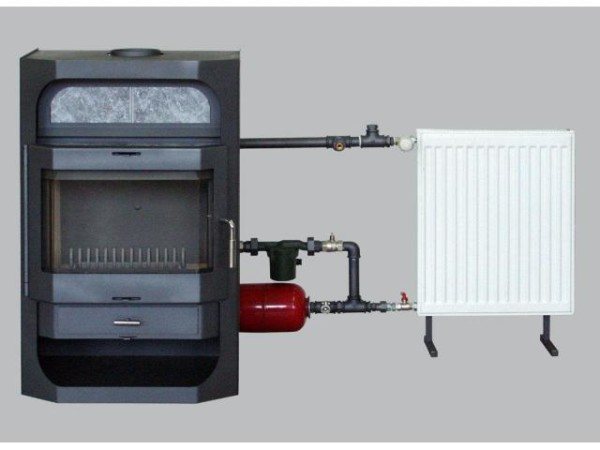

Stoves for a bath with a water circuit for heating and the needs of hot water supply began to appear after ordinary water heat generators received good reviews. By its design, furnace equipment with an integrated water heating circuit is divided into several classes:
- The coil is the simplest device used in classic solid fuel boilers. A bent metal tube is located inside the structure. The shape is different and depends on the features of the internal design of the furnace. The coil is positioned so that the flame does not directly affect it, but heating is carried out by means of flue gases.
- A flat heat exchanger is a more complex device than the previous one. A flat heat exchanger for a sauna stove looks like two hollow plates connected to each other. In terms of thermal efficiency, the design surpasses the coil used in modern models of furnace equipment.
- Built-in tank - a separate container is made in the furnace, installed on top of the combustion chamber. The built-in horizontal heat exchanger heats up quickly and maintains the temperature as long as the oven remains hot.
- Water jacket - represents a cavity surrounding the entire combustion chamber and smoke channels. The design is often used in the production of solid fuel boilers, but has not been widely used in the manufacture of sauna stoves.
The principle of operation of an integrated heat exchanger in a sauna stove is as follows. The spiral or plate is heated by flue gases, the temperature of which reaches 450-500 ° C. When heated, pressure arises, forcing the coolant to circulate in the heating system. In schemes where an indirect heating boiler is used, the DHW is heated by heating heat.
Samovar type
Installing a heat exchanger on a sauna stove is a budget solution to the problem of hot water supply and heating. The hot water device is manufactured in two ways:
- Coil - a coil made of aluminum or copper is installed on the chimney. For systems with natural circulation, up to a storage tank or water distribution taps, the dimensions of the coil should not exceed 3 m. The optimum dimensions for a heat exchanger with forced circulation are 5 m.
- Samovar-type heat exchanger device - experts agree that it is this design that is optimal for a bath. The hot water for the shower is prepared gradually to prevent the liquid from boiling.
The movement of water in a samovar-type heat exchanger occurs according to natural physical laws. The heated liquid rises upward, pressure is created in the container.
The optimal volume of a samovar-type heat exchanger is chosen so that the water reaches the required temperature after 2-3 hours of intense combustion. The design is optimal for providing hot water supply.
It is easy to guess that in the case of a flowing water circuit or a tank hung on the chimney, it is necessary to ensure constant circulation of liquid between it and the storage tank outside the steam room.
This can be done either due to the natural laws that water obeys (and such a system is considered open), or with the help of a pump that provides forced circulation.
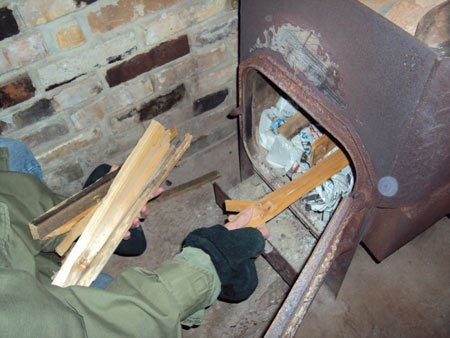

IMPORTANT! Natural circulation based on gravity and convection is preferred. The connecting pipes must be at least one inch in diameter and no more than 3 meters in length.
Look at the diagram above, which clearly shows how to position the pipes so that the water rises and falls unhindered. There is a video explaining the diagram below.
DANGEROUS! Make sure there is water in the system before lighting the stove!
Construction stages
Pit for a sauna stove
The procedure for arranging a monolithic foundation for a stove in a bath does not differ from the general sequence of actions for the construction of a typical base. It includes the following steps:
- pit preparation;
- arrangement of formwork;
- pouring concrete mixture.
The construction works of various foundations differ in some details.
Under a brick oven
Step-by-step instructions for building a foundation for a brick oven:
- The trench is marked and the soil is selected to a depth of at least one meter.
- Crushed stone is poured into it, which is then carefully rammed.
- The bulk layer of the pillow is calculated for a thickness of 30 cm.
- A pre-prepared concrete mixture is poured.
Under a metal oven
The concrete slab must be installed strictly horizontally
A foundation for a metal stove in a bath is required only in cases where the weight of the structure exceeds 150 kg. Its use allows the oven to be installed strictly horizontally and to guarantee its constant position. The slightest deviations lead to deformation of structural elements and deterioration of its characteristics.
The order of operations for the construction of the foundation for the stove:
- Marking is made and a small trench is pulled out (no more than 0.5 meters deep).
- Crushed stone is poured in a thin layer, which is immediately compacted.
- A concrete mixture is poured in the same proportions.
Similar to the first case, waterproofing is done, the finishing layer of which is leveled.
Pile foundation
Arrangement of the pile foundation takes time, but the structure is durable
The procedure for arranging a support-pile foundation for brick ovens is somewhat different, since in this case a different technology is used. It consists in the construction of a series of pillars or pile supports, on which a frame is subsequently placed under the furnace structure.
Sequence of working steps:
- On the prepared site, markings are made corresponding to the dimensions of the furnace with an overlap of 10 cm on each side.
- With a bayonet shovel, about 20 cm of soil is removed, after which pegs are driven along the perimeter with a certain step, between which the string is pulled.
- At the intersection of individual threads, marks are made, along which holes are then drilled about 50 cm deep and 20 cm in diameter.
- Formwork is made from wooden planks in the shape of pits, and then installed in them.
- The bottom is closed with a 15 cm thick layer of sand, which is then carefully compacted.
Upon completion of these procedures, gravel is poured on top and filled with clean water, after which a reinforcing frame is knitted from a reinforcing wire with a diameter of 0.8 mm. Piles are installed in its center, the function of which is performed by asbestos pipes of appropriate length.
At the final stage of work, the entire structure placed in the pit is poured with concrete, the shrinkage and drying of which takes about 2 weeks. After that, they proceed to pouring the platform for the furnace, resting on the finished piles. It also takes about 2-3 weeks to dry.
Concrete foundation
Natural stone with cement mortar is the most durable foundation material
Step-by-step instructions for building a rubble foundation for a stove:
- A trench is marked for pouring the base, the size of which is chosen 10 cm larger than the dimensions of the furnace, taking into account a small margin for formwork.
- A pit breaks out along the markings, at the bottom of which a pillow is made of selected rubble 15 cm thick.
- The formed layer is carefully rammed, after which several large rubble stones are placed on the very bottom (their diameter should not exceed 15 cm).
- Crushed stone is poured on top, filling the voids between the stones.
- A cement-sand mortar is poured into the trench to the depth of the layer, in the manufacture of which the classic ratio of 1 to 3 is used. For its preparation, cement of the M400 grade or higher is best suited.
After a day, another layer of stones is laid on top of the frozen mass, which are also filled with the same concrete composition. This procedure is repeated until the entire trench is filled with the quarry. After that, a building level is taken and with its help the resulting surface is checked for evenness. The detected irregularities are eliminated with the help of a liquid cement-sand composition.Then the base is covered with plastic wrap and left to dry completely (at least 2 weeks).
About the types of foundations for a brick oven
To begin with, the foundation for a brick oven can be ground and underground. Ground-based ones are used less often, mainly in cases when the furnace structure is being built on the second floor. The underground foundation, on the other hand, is much more widespread.
If we consider the most suitable type of base, taking into account the material, then for a brick structure, a pile base or a platform made of rubble concrete material would be the best solution. We will describe the principles of their arrangement below.
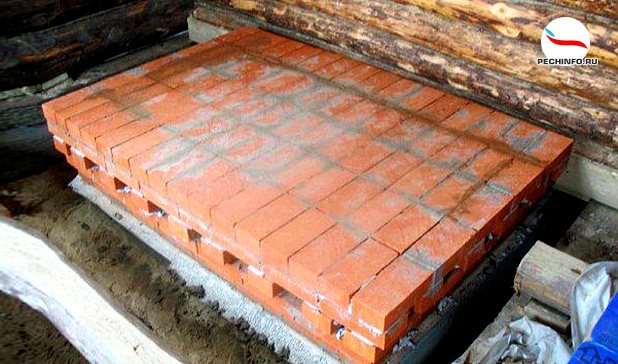

Basic rules for laying the foundation
Whatever version of the foundation for the furnace you choose, and whatever size you decide to implement, there are a number of basic rules that you should not ignore:
The foundation for the stove must be made independent, in no way connected with the foundation of the whole house. Why? The fact is that during operation, the house may shrink slightly. When lowering, he should not pull the stove with him, as this can lead to its deformation, deterioration of traction and violation of technical properties.
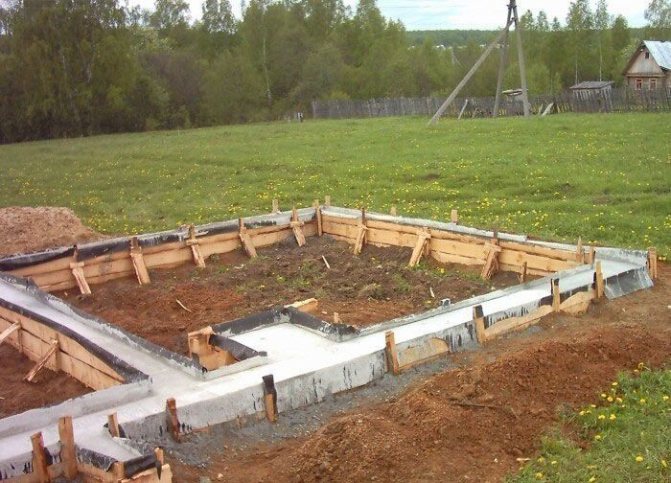

The foundation for the furnace is separated from the general
In some cases, you can partially combine two bases by connecting them with one wall.
- If both foundations (for the house and for the stove) are located close to each other, sand backfill with a thickness of 50 mm must be made between them.
- If the foundation for the common house is tape, then the base for the furnace should in no case come into contact with this foundation with the walls.
- When choosing a place for a stove and, accordingly, a foundation, one should not only rely on wishes, but also on factors such as: the location of doors, windows and roof beams. The location of the chimney should be taken into account so that the pipe does not fall into the ceilings and beams during the construction of the stove.
- When calculating the size and depth of the foundation, be sure to take into account the severity of the floors and the weight of the stove together with the chimney.
The dimensions of the foundation are influenced not only by the dimensions of the furnace, but also by the density of the soil on which it is being erected. The main load in the furnace is usually created by the chimney, therefore, when designing the furnace, it is necessary to carry it closer to the center of the base. This will help to avoid asymmetric loading and premature, improper shrinkage of the oven.
Sometimes, when designing a very large and massive stove with a stone chimney, stove-makers make a separate base for the chimney.
Also, the choice of foundation depends on the material of the furnace. For a metal structure and a stone one, it will be different in depth, the entire mass of a brick oven is at least 400-500 kg, while a metal oven weighs about 150 kg.
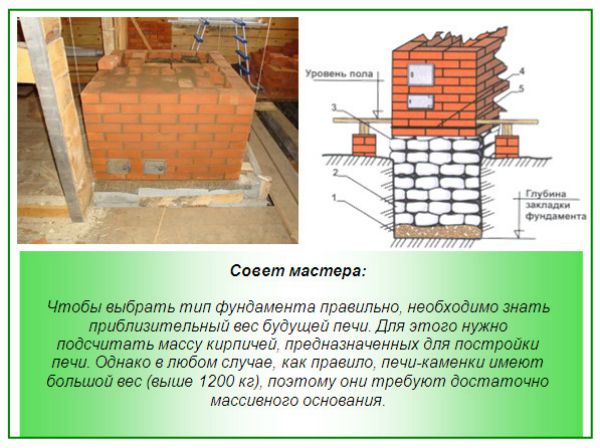

How to calculate the weight of a stone oven
In principle, for a small metal stove, you can separately and not equip the foundation, especially if it is being built in a house that stands on a tiled monolithic base.
The density of the soil and the degree of its freezing play an important role in determining the size of the foundation. The climate in Russia is accompanied by rather severe winters practically throughout its entire territory. Therefore, the foundation for the furnace should be laid to the entire depth of soil freezing.
The type of soil is also of great importance.
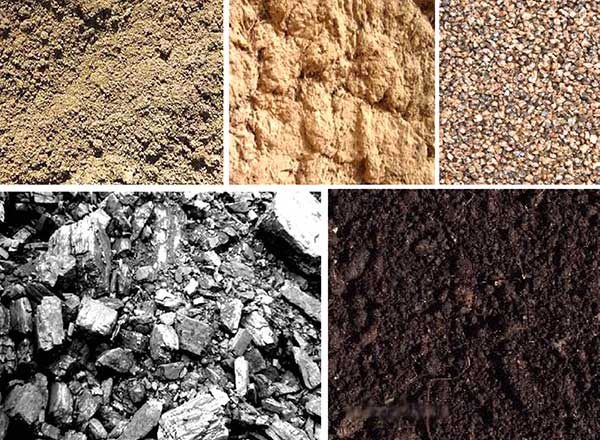

Soil types
It is of three types:
- clay;
- sandy loam;
- loam.
In places where a large number of rivers, reservoirs, lakes prevail, as a rule, sedimentary types of soil are found. Here, it is better to entrust the construction of the foundation for the furnace and the house to professionals, so the calculations of the point of passage of the waters should be carried out.
In Central Russia, a very common type of soil is loam, which is a mixture of sand and clay. It is clay that predominates in it, therefore such soil is less plastic.
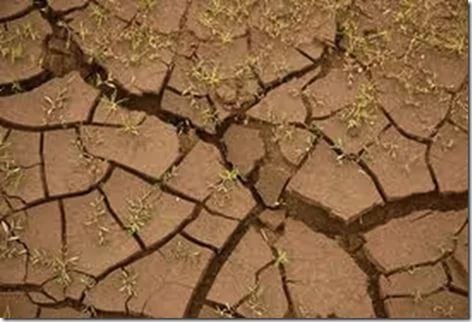

Loam
Erection of a foundation on such soil is usually associated with hassle and additional problems, since in a dry state the loam is crumbly, with the onset of frost it begins to "heave", and with a large amount of sediment it becomes viscous.
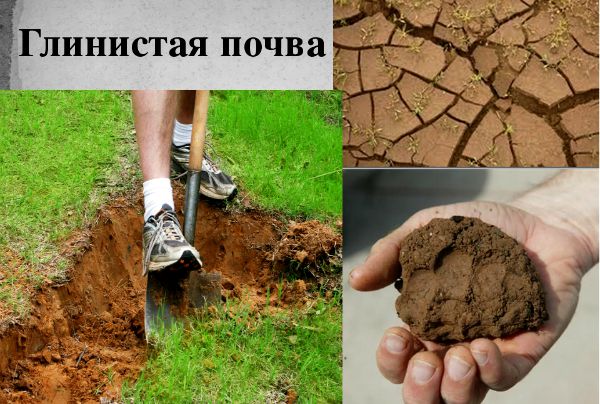

Clay soil
Therefore, in this case, the depth of laying the foundation for the furnace must be made above the freezing point.
But in forest areas, on the contrary, it is necessary to lay the foundation for the stove below the freezing point of the soil and equip the base on a sand cushion 60-90 cm thick.
One of the most reliable types of soil for building a foundation is gravel and rocky, but, unfortunately, sometimes you have to build a house and a stove on an unstable one. Competent construction of a reliable foundation will help neutralize this fact.
Varieties of furnace foundation
The foundation for the stove in the house has a different location in relation to the ground level. According to this criterion, it is divided into two types:
- ground;
- underground.
The base of the first type is used in the construction of stoves on the second floors, and underground foundations are the basis for the construction of stoves on the first floors.
If it is planned to build a furnace in two tiers, a combined foundation is required for it. The load from the furnaces located on the first level is transferred directly to the foundation structure and then to the ground. The load from the stoves, erected on the second floors, goes initially to the supporting structures of the building, then to the base.
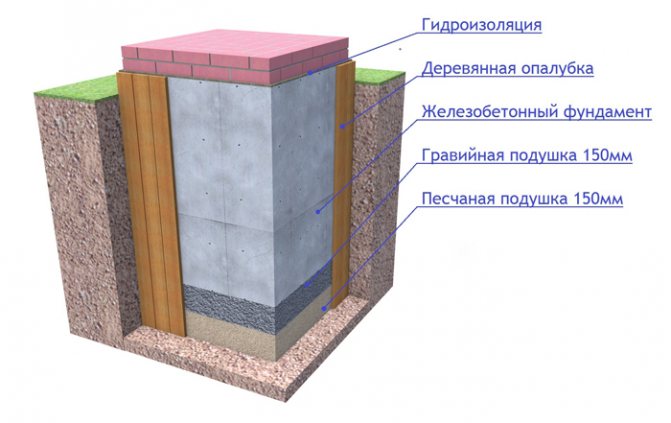

For light oven
For a furnace assembled with sheet steel, which weighs no more than 150 kg, a separate foundation is also required. To do this, a pit is dug to a depth of 0.5 meters. Its length and width will directly depend on the size of the oven. After that, crushed stone is poured onto the bottom with a layer of 30 cm and compacted well.
Then a solution of cement of medium density is prepared. For this, 4 parts of sand, 1 part of cement and water are taken. This mixture is poured into crushed stone in the pit and left in this form for a day to solidify. In this way, the sole of the foundation is created.
After this time, in order to create waterproofing, roofing material is laid on the surface of the dried cement in two layers.
Next, concrete is prepared for pouring. Take 2.5 parts of sand, 4 parts of fine gravel, 1 part of cement and water. The pit is poured with the ready-made mortar to the required foundation height. And finally, using a level, the foundation surface is leveled to a horizontal state.
The kiln foundation is the most important structure in the entire structure. If it is made using high-quality materials and in compliance with all the rules, then it can last long enough on any soil, without creating unnecessary trouble for any design of heating equipment
Stove-makers tips
- Consider the total weight of the brick stove when choosing the type and material. So, if the total mass of the structure is less than 750 kg and it will be erected on the first floor, a simple reinforced concrete base is quite enough. If the weight exceeds the specified figure, it is worth considering the construction of a separate foundation.
- The ideal and very reliable solution for lightweight brick ovens - columnar base. The pillars dug to a sufficiently deep depth work like piles. And already the role of support is performed by a reinforced concrete slab placed on the ground.
- Do not connect the base of the stove and the house or a sauna building, since the foundation must take the load coming exclusively from the stove. The gap between these two bases is about 5 cm and is filled with sand in two layers or laid with waterproofing.
It will become clearer to you how to fill the foundation for a brick stove in a bathhouse or a wooden house if you take the time to watch the video.
We wish you good luck with your work!
New house
At the planning stage, an oven is included in the house.
This means that the project will be calculated together with the loads from its device.
It goes without saying that the stove in this case will be the easiest to arrange on the same basis as the house.
As a result, we should get a monolithic ideally flat surface in area larger than the future structure.
If the foundation of the house is built with a pile or pillar method, then it is not enough to bring additional supports under the furnace, it is necessary to tie them into a single structure and fill it with a monolith slab of the required size.
To install a new stove in an old house, you need to remove the floor
When installing a stove or fireplace in an already built and inhabited house, you will have to remove the floor. In fact, you need to get to the ground
In such a situation, at the design stage, it is very important to correctly calculate the weight of the future structure. If the body weight does not exceed 0.8 t, then you can stop at shallow concrete pouring
If a large-scale oven is planned, then a solid foundation is needed.
Material selection
For the construction of the foundation, you can choose the following raw materials:
- rubble stone;
- concrete;
- iron brick, etc.
The main thing in this choice is to take into account such an important circumstance as the strength of raw materials, because the material must be resistant to moisture. This condition is most important for wet soils, on which the foundation for a stove in a bath is often set up. The most suitable option for such soils would be a concrete foundation. But if a different material is chosen for construction, it is imperative to use cement mortar when masonry is performed. If the soil is dense and dry, in this case it is recommended to use lime or cement-lime compositions.
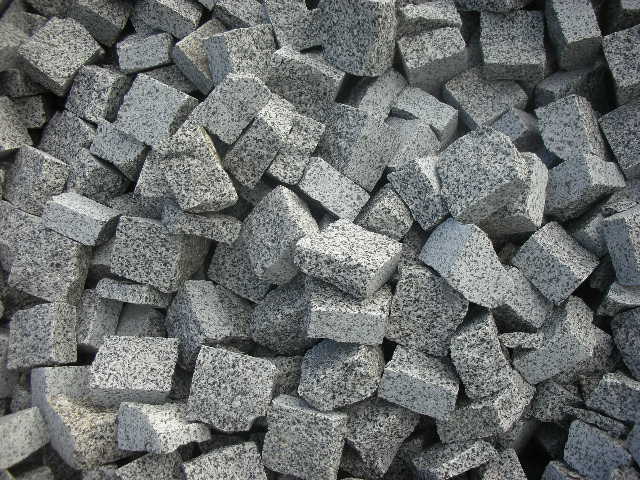

Concrete foundation
To build the foundation for the furnace you will need:
Cement.
- Coarse sand without inclusions. The ideal option would be to use mountain sand, but sea and river sand are also suitable. We have already considered the methods of cleaning sand from impurities on the pages of our Internet resource.
- Formwork material.
- Crushed stone.
- Roofing material or dense polyethylene.
Instruments:
- Solution trough
- Shovels: bayonet, shovel
- Building level
- Hammer, nails, hacksaw for formwork construction
- Construction stapler
Do I need to go deeper
You can start building the foundation for the stove. Many people may wonder whether it is necessary to go deep into the ground when the foundation is being built with their own hands under the stove. Our answer is obligatory. Sometimes there is an option in which the foundation is arranged with a shallow depth. Only the upper vegetation layer is removed and after the installation of the formwork, the foundation is poured. This is completely wrong way. The slab of the foundation, arranged in this way, will constantly experience loads, especially in the winter. The motivation for the economical consumption of building materials when constructing such a foundation is not justified by anything. The deepening must be carried out to a depth below the freezing level in your area. You can use a shallow foundation in a bathhouse under the oven, but with the obligatory installation of piles under the main foundation slab.


3298747c3106dbca1d54e8cc0871aa17.jpe
Pit construction - basic parameters
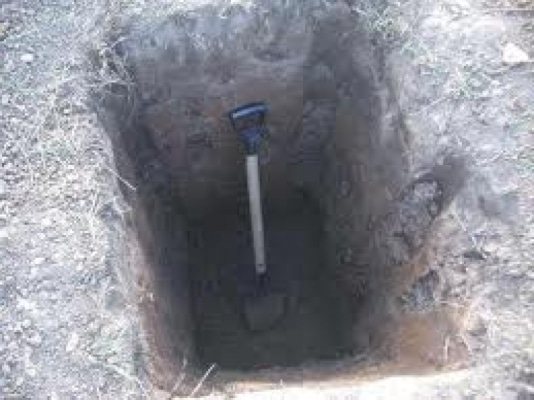

Digging a pit
For dry, sandy soils, 500 - 600 mm is enough. But on heaving soils, this depth should not be less than 1000 mm. We repeat - this is the correct foundation.
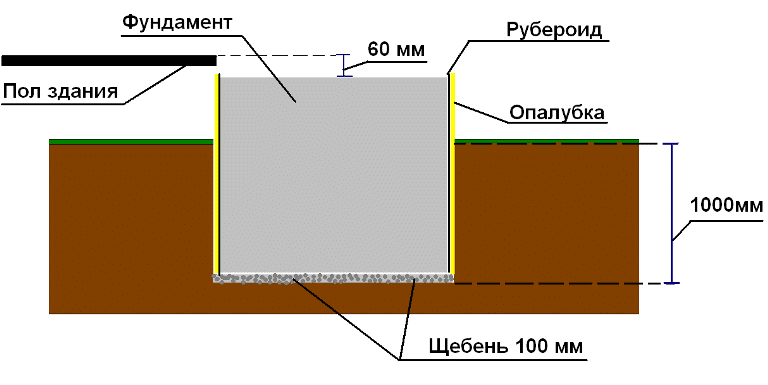

Correct laying of the foundation
We dig a foundation pit according to the markings. The size of the pit must allow the installation of the formwork. But if the soil on your site is dense enough and the edges do not crumble, you can do without it. In any case, it all depends on the specific location and soil. When the formwork is installed, a layer of crushed stone 100 mm thick is poured onto the bottom of the pit. Crushed stone must be leveled. After that, it is necessary to compact the crushed stone with a manual rammer.
Waterproofing and filling
For waterproofing the foundation, a layer of roofing material is attached to the inner side of the formwork using a construction stapler. You can start pouring
It is important to know that the upper level of the foundation should be 60 - 70 mm lower than the main floor of the building. We prepare the solution in the following proportions:
- Cement 1 part
- Sand 3 parts
- Crushed stone 5 parts
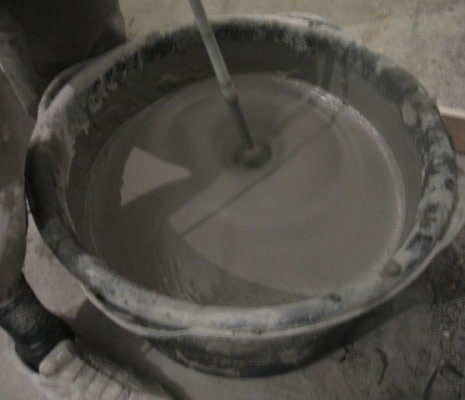

Solution
- First, a dry mixture of cement, sand and crushed stone is prepared. You can use mortar for laying the oven.
- After shoveling and obtaining a homogeneous mass, water is gradually added until a solution of the consistency of thick sour cream is formed. The solution can be poured.
The need for a foundation for the furnace and sizing
Some owners of country and private houses are interested in whether a foundation is needed for a stove? To resolve this issue, it is necessary to determine the dimensions of the future structure. The weight of the furnace also determines the need for arranging the base. The newly laid structure will weigh approximately 8 tons, after the mortar has dried, the weight will be halved. Sometimes a separate foundation is formed for the main chimney, this eliminates uneven shrinkage.
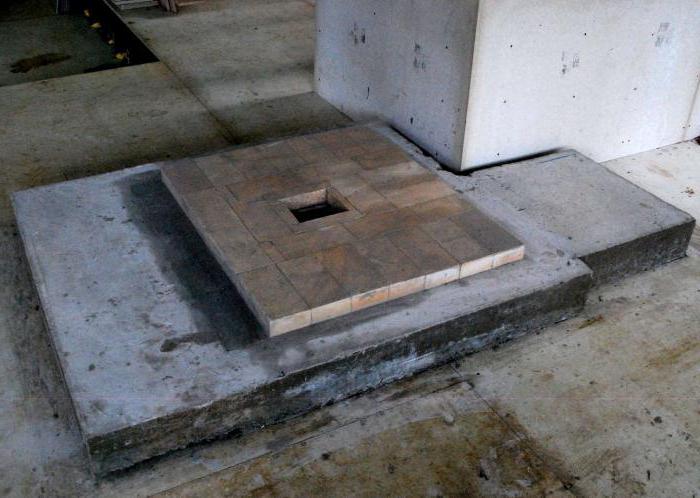

The depth of the base will depend on the strength of the soil, the heaving of the soil, the depth of freezing, the foundation of the main building, the level of the location of groundwater, as well as the question of whether the construction of the main building is completed at the time the foundation for the furnace is erected. On dry sandy soils, the foundation for the furnace must be laid at 80 cm. If we are talking about heaving soils, then the depth should be 1.5 m or less below the freezing line. In order to determine whether a foundation is needed for a furnace, you should calculate its future mass using a formula that looks like this:
- P = 1350 x V, where V is the volume of the masonry in meters; 1350 - approximate weight of 1 m2 of masonry in kg (mortar + about 200 bricks).

